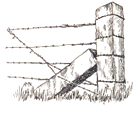Archive for the ‘Riddle’ Category
A Hunt for Michigan Death Records
 How do you document the death of an ancestor? We usually search for five different records:
How do you document the death of an ancestor? We usually search for five different records:
- Death certificate
- Obituary
- Cemetery Record
- Funeral Home Record
- Funeral Card
In an effort to be thorough with this, I have sought to find these five records for the couple I am researching this year, John Davis Riddle and his wife Olive Hall Dunbar. I have not had complete success with this.
Both John and Olive died in Mendon, Michigan. He passed away in 1896 and she in 1902. So far, I have collected these records:
John Davis Riddle
- Although Michigan began keeping state death records in 1867, compliance was low until 1897. The state does not have a record of John Davis Riddle’s death. St. Joseph County, however, kept their own records, and his death is listed on the county register. The record provides age; date, place, and cause of death; state of birth; occupation; and parents’ names. John Davis Riddle’s parents were Unknown.
- I have not located an obituary for John Davis Riddle. Years ago, the Mendon library told me that back issues of the local newspaper had burned. Surrounding community newspapers reported his death because he died at his own hand, but these accounts did not include biographical or funeral information.
- The Mendon library told me the Mendon Cemetery records also had burned. I do have a photograph of his cemetery marker.
- Without a death certificate or an obituary, I do not know the name of the funeral home that conducted his funeral.
- Because he died by suicide, I do not know what type of funeral or memorial service he had. Relatives back in Michigan do not have a funeral card.
Olive Hall Dunbar Riddle
- I have Olive Riddle’s death certificate from the State of Michigan.
- Again, I have no obituary because back issues of the local newspaper were destroyed in a fire.
- Cemetery records were also destroyed in a fire. As with John, I have a photograph of her cemetery marker.
- The death certificate provides the name of the funeral home, [?] & Shoemaker. I am attempting to locate their successor in interest and their records.
- I have not located anyone who has saved a funeral card for Olive.
It appears I have done all I can to document these deaths unless I can track down the funeral home that made their final arrangements. I was disappointed that neither death record listed the names of parents. Luckily, family papers provided me with the names of Olive’s mother and father, Rhoda Hall and Benjamin E. Dunbar. No one has any information on John’s family, and this makes him one of our brick wall ancestors.
Living in the Great American Desert
 One hundred forty years ago, the one-armed explorer and geologist John Wesley Powell drew a long line in the dirt. This survey line, along the 100th meridian, runs north-south through the Dakotas, Nebraska, Kansas, Oklahoma, and Texas. It marked the then-separation point between the arid west and the more humid east.
One hundred forty years ago, the one-armed explorer and geologist John Wesley Powell drew a long line in the dirt. This survey line, along the 100th meridian, runs north-south through the Dakotas, Nebraska, Kansas, Oklahoma, and Texas. It marked the then-separation point between the arid west and the more humid east.
Powell, who lost his arm during the Civil War battle of Shiloh, explored much of the American West. He observed the climate and was wary of allowing settlement in the dry area west of the demarcation line he had identified. The United States government ignored his recommendations. They encouraged the settlement of the West, and today I, and many others, live on the Great Plains.
Here, nothing much will grow without supplemental water because we receive little rain and snow. Our fields must be irrigated with large sprinkler systems. Our lawns, too, have automated watering. We constantly worry about and squabble over water supplies.
A constant influx of people every year means that the same amount of water must be shared by more and more people. They come here to enjoy our abundant sunshine and to escape what one local politician describes as the lawless cities on the west coast.
My water portion inevitably must be reduced. Just yesterday a few of my neighbors and I walked about my neighborhood with a landscaper who specializes in low-water-use designs. We must do something to rid ourselves of acres of thirsty Kentucky blue grass before our local water department cuts off our supply of water for outdoor use.
Yet even with this bleak outlook, I will stay on because I have deep roots here. My people first came to this land in the 1880’s shortly after Powell published his findings. Both my dad’s grandmothers took advantage of the Homestead Act to attempt farming in the west. When faced with scant water supplies and harsh weather, neither had much success:
- Laura Riddle (1853-1933) arrived in McCook, Nebraska in 1885 with three sons in tow. They took a 160-acre homestead near her sister’s family in Red Willow County. Later, Laura moved west to another homestead in Hayes County. When 320-acre tracts became available early in the 20th century, she moved west yet again to Dundy County. Life for her was hard, very hard, and she even had to hand over her only daughter to a sister to raise.
- Anna Petronellia Sherman Reed (1865-1961) homesteaded alone in Wyoming after World War I. She settled northwest of Cheyenne where she detested the wind and treeless landscape. Life for her, too, was difficult on the homestead. One year, her only crop was a bucket of potatoes. She sold her place as soon as she was able to prove it up and moved back to Missouri.
These women came west because they could not make a living elsewhere. Their families stayed on and remain here today. Despite our challenges with water, we hope our leaders can find solutions to the water supply problem. It helps if we each do our part to conserve.
Powell was right that the Great American Desert presents an inhospitable land. Not many have had success with farming here. Ranching and mining presented greater opportunities. Today, climatologists are observing that the dividing line Powell identified may be shifting eastward from the 100th meridian due to climate change. Additional settled areas will face the need to adapt to a dry climate as we have. Powell’s observations about the West were correct.
A Promising DNA Match
 You always hope that DNA testing will help you make a breakthrough on one of your blocked ancestral lines. After all, that is one of the reasons for taking the test. This week, I got lucky.
You always hope that DNA testing will help you make a breakthrough on one of your blocked ancestral lines. After all, that is one of the reasons for taking the test. This week, I got lucky.
My dad and I took the tests with a couple of companies a few years ago because we have some unidentified ancestors in recent generations. Traditional research has gotten me nowhere in identifying these ancestors:
- The parents of my great-great grandfather John Davis Riddle (1821-1896)
- The mother of my great-grandmother Anna Petronellia Sherman (1865-1961), reported in family papers to be a German immigrant to Indiana named Katherine Stillenbaugh/Stanabaugh.
- The father of my grandmother Grace Riddle (1896-1976).
Over many months I have periodically reviewed our DNA matches searching for a clue on one of these lines. Most of our matches were quite distant, 4th cousins or so. For those whose names I recognized, the Most Recent Common Ancestor was someone I already had in my family tree, and the matching information did not provide any help other than to confirm that we are genetically related. For those matches whose names I did not recognize, identifying common ancestors proved very difficult, and often I have not yet been able to discern the relationship.
Then there were the close matches—2nd cousins to my dad. Both were adoptees searching for their birth parents. One lives in Montana and the other in Nebraska. We had forebears in both states, but I am sorry to say I was unable to determine how we are related to these two people. I could offer them no help.
Despite the lack of real progress from DNA testing, I keep trying to learn more about the process. Yesterday, I listened in on a Legacy webinar by Blaine Bettinger, author of The Family Tree Guide to DNA Testing and Genetic Genealogy. He reminded listeners that the testing companies have the option to post family trees. He advised looking over those posted by your close matches. I had some time and decided to do that again.
Some of my matches had no trees posted. Others were not available for public viewing.
Then I came to one for a man identified as a 2nd-4th cousin to my dad. His tree lists a great-grandmother named Lula Stilabower.
I have long suspected that my ancestor Katherine Stillenbaugh/Stanabaugh was actually a Stillabower/Stilgenbauer. This large German immigrant family (including Lula) lived in the same area south of Indianapolis where my great-grandmother Anna was born to the mysterious Katherine. Now I have a DNA match to someone from that family.
Of course this is not conclusive proof that my DNA match and I are related through this line. To do that, I need to find another person who descends from the Stillabower/Stilgenbauer line and who matches both of us. Even with DNA proof, I still will not know how my Katherine fits into the Stilgenbauer family.
But this clue is a pretty good start. As more and more people test their DNA I might just get that third person who will enable me to triangulate this result. I would love to verify my descent from the Stilgenbauers and learn more about that teensy bit of German heritage (1/16) that I have.
The Dunbars Come to Life
 My great-grandmother, Laura Riddle, grew up on a farm in Mendon, St. Joseph County, Michigan. Her parents, John Riddle and Olive Dunbar, moved there in the late 1840’s, and Laura was born in 1853.
My great-grandmother, Laura Riddle, grew up on a farm in Mendon, St. Joseph County, Michigan. Her parents, John Riddle and Olive Dunbar, moved there in the late 1840’s, and Laura was born in 1853.
I do not know why the Riddles migrated from Ohio to Michigan. I have never found any members of the Riddle/Dunbar circle who beckoned Olive and John Riddle to that place at that time. Their motive for relocation and their reason for choosing Michigan as their destination remain a mystery. They appear to have been true pioneers.
This week I learned that even though the Riddles did not seem to follow anyone else when they moved to Michigan, others in Olive’s family later followed them. Her older sister Susan H. Dunbar Cutting’s family went to live in the same township during the Civil War. I had not suspected this because Susan Cutting later returned to Ohio and was buried there. I had no reason to believe she ever lived anywhere else.
This information came to light when I received obituaries for Susan and her daughter-in-law Amanda from the Akron, Ohio public library. After reviewing the obituaries, I went to Find A Grave (www.findagrave.com) seeking more information on the Cutting family. It was sketchy.
I decided to help fill it in by submitting an Edit suggestion for Susan’s memorial to connect her to her parents, Rhoda Hall and Benjamin E. Dunbar. The memorial manager responded immediately, not only by posting the connections, but also by adding a tremendous amount of biographical information for Susan and her family. Thus, I learned that they had spent time in Michigan. Both of Susan’s daughters, Mary and Clara, had died young in St. Joseph County, Michigan. Mary Edna Cutting Ulum had wed and died in childbirth during the family’s Michigan stint. Unmarried Clara Cutting died about the same time.
My great-grandmother Laura had had first cousins on her mother’s side of the family living nearby only to lose them to untimely deaths.
Susan’s Find A Grave memorial had information about Susan’s son, DeWitt Clinton Cutting, too. He had served in the 128th Ohio Infantry during the Civil War.
These people seem more real to me now that I know a bit more about their lives. The Riddles, instead of being isolated in Michigan, had close connections with at least some of their relatives on the Dunbar side. They did not simply move north and lose all contact with family.
Olive had numerous other siblings in addition to Susan Cutting. Perhaps I can use some of the same strategies to find out more about some of them, too.
Good Library Help from Indiana and Ohio
 Recently I read an article by Curt Witcher, a well-known genealogy librarian at the Allen County Public Library in Indiana. He wrote about getting more online for your family history.
Recently I read an article by Curt Witcher, a well-known genealogy librarian at the Allen County Public Library in Indiana. He wrote about getting more online for your family history.
He suggests that a good research plan begins with checking the local public library. These libraries often have searchable records or links to other important sites.
I decided to give this a try and look for more information on my brick wall ancestor John Davis Riddle who married Olive Dunbar in Summit County, Ohio in 1843. I do not have any information about J. D. Riddle before that date except that he was born in 1821 in Pennsylvania. Perhaps one of the Summit County libraries would have some resources to help along my search for him.
I know that Olive Dunbar lived in the city of Stow in Summit County prior to her marriage, so I began there. I found that the Stow-Munroe Falls Public Library website (http://www.smfpl.org/) has a genealogy section.
This website proved quite valuable. There a found a map of Stow from the time when my Dunbar family lived there. I filed it away for future reference.
I also found a link to the online index of Ohio obituaries at the Rutherford B. Hayes library. It names the Ohio newspaper that printed each obituary and tells where to find it.
Some of Olive Dunbar’s siblings had remained in the Stow area, and I found several family names on this index. A couple of their obituaries had been printed in the Akron, Ohio newspaper. The index pointed me to the Akron-Summit County Public Library (http://www.akronlibrary.org/) which offers an obituary look-up service at no cost for electronic copies. I collected these and filled in more of Olive Dunbar’s family tree.
Unfortunately, I have not yet found the Riddle family name on any of these library resources. The origin of John Davis Riddle remains a mystery.
There may be more for me to discover in the libraries of Summit County. I have not yet given up hope. If nothing turns up there, I will move on to the next step suggested by Mr. Witcher—the State library.
George Edmonds—Another Clue
 Family lore tells me that my great-grandmother Laura Riddle (1853-1933) once married a man named George Edmonds. Who was he, and what happened to him?
Family lore tells me that my great-grandmother Laura Riddle (1853-1933) once married a man named George Edmonds. Who was he, and what happened to him?
I have never found a marriage record for this wedding, but George and Laura did have three sons together. Francis (Frank) was born in Berrien County, Michigan in 1876; Lewis was born in St. Joseph County, Michigan in 1877; and Joseph was born also in St. Joseph County in 1880. The 1880 U.S. census reports the young family living in Leonidas, St. Joseph County, Michigan where George (born in NY about 1849) worked as a farm laborer. George Edmonds, farm laborer, also appeared on the 1870 U.S. census for Van Buren County, Michigan.
By 1884, George no longer lived with Laura and the boys. The 1884 Michigan State Census records her and her sons in the household of her father, John Davis Riddle. George Edmonds’ name does not appear on this census. No one in my modern-day family knew why the family split up or where George went after 1880. Perhaps he had died…
About twenty years ago, I took a stab at unraveling this mystery. Back then, research was expensive. To look at microfilmed Michigan records I had to pay to order microfilm rolls from the Family History Center. Money was tight with teenage boys in my household. Rarely did I feel I had the money to order multiple rolls of film from St. Joseph and surrounding counties to find records of George Edmonds.
When I did splurge to order a film, I usually found nothing about George. If he died in St. Joseph County, his death was not recorded. He never seemed to own any land. The only clue that turned up was an 1884 marriage index entry showing a George Edmonds marrying Mauda Kathkart. Was this the same George? I did not order the record but kept the clue for later followup.
Ordering county records directly from St. Joseph County back then was difficult. The judge there was unfriendly to genealogists and instituted a policy whereby only his approved researcher (just one) could view and copy the county records. The county court would not respond to mail inquiries. This policy made county courthouse research impractical and had a real chilling effect on St. Joseph County research.
Since those days, Michigan research has become much simpler. The Family History Center has many of their Michigan microfilm rolls online. The website Seeking Michigan (seekingmichigan.org) provides even more online records. I decided to look again for George Edmonds.
This week on Family Search I navigated to the 1884 St. Joseph County marriage records. Instead of an index, I could now see the county record itself for the Edmonds-Kathkart marriage. It contains a great deal of information not included in the index I had viewed so many years ago. I learned this George, like mine, was born in 1849 in New York. The record even provides a specific birthplace—Chatauqua County. The marriage took place in Sturgis, Michigan, but both parties were residents of La Grange County, Indiana, just south of the state line. The bride was only 16 years old.
It looks like George left Laura and the children to marry a girl half Laura’s age. Armed with George’s birthplace and his 1884 Indiana residence, I may now be able to track him through time to find out more about his family. Going back to look at the original county record has opened some promising new lines of inquiry.
I still do not know whether George and Laura formally married. She resumed her Riddle maiden name after their parting. The boys were usually known by their Edmonds surname although the middle son, Lewis, sometimes went by Riddle.
As I continue to investigate what happened to George Edmonds, I need to keep in mind that there was more than one man with that name in Michigan and Indiana during this time period. Untangling these individuals will not be easy.
A False Lead in the Search for John Davis Riddle
 Oftentimes, we genealogists hear cautionary advice about trusting family trees we find online. So many of these have no sources attached, and we cannot verify the information. In other words, we cannot take a family found on the internet and assume it is correct.
Oftentimes, we genealogists hear cautionary advice about trusting family trees we find online. So many of these have no sources attached, and we cannot verify the information. In other words, we cannot take a family found on the internet and assume it is correct.
This month I learned the soundness of this advice. For years, I have searched for the birth family for my ancestor John Davis Riddle (1821-1896). Family papers and the U.S. census for Michigan tell me that he was born in Pennsylvania.
As I resumed research on him and his line this year, again I looked online for any family trees that included his name. Usually I have found nothing, but this time I located a tree connecting him to a Riddle family in Chester County, Pennsylvania. A clue, at last! Was this the breakthrough I have sought so long?
I eagerly contacted the person who had posted the tree. I wanted to find out how they had matched the Davis/David Riddle in Pennsylvania to the John Davis Riddle of Mendon, Michigan. My hopes were dashed after we exchanged messages. Unfortunately, the person had simply hypothesized this relationship without any real proof. He/she had added John Davis Riddle and his children to the online tree on spec, hoping to locate relatives and to identify DNA matches. The posted tree was a fishing expedition although it was not labeled as such.
Am I again at a dead end? Perhaps my John Davis Riddle did hail from the Riddles of Chester County. But so far, no one seems to have any documentation for that. It is disappointing that an unproven family tree was out there to mislead the unwary.
After my correspondence with the person who posted the erroneous tree, it has been removed. But how long had it been up there? I wonder how many people viewed it and copied the unproven relationship into their own trees before I questioned the information. I hope they all knew to verify family trees they found online.
I make it a practice in my own research to post only information that I have verified. I have provided source lists for every fact I put online. You will not find hypothesized information in my online trees.
The hunt for a family for John Davis Riddle continues.
Three Nebraska Homesteads
 The Homestead Act of 1862 opened up settlement in the western United States. Adult heads of families could apply for land at little or no cost in return for five years of residence on the land. A quirk in the law, intentionally or not, allowed women to apply for a homestead. This enabled many women with no other means of support to establish small farms and later sell them, pocketing a nice sum of cash to live on.
The Homestead Act of 1862 opened up settlement in the western United States. Adult heads of families could apply for land at little or no cost in return for five years of residence on the land. A quirk in the law, intentionally or not, allowed women to apply for a homestead. This enabled many women with no other means of support to establish small farms and later sell them, pocketing a nice sum of cash to live on.
My great-grandmother, Laura Riddle (1853-1933), was one of these women. She had three homesteads in Nebraska:
- Lands near McCook, Red Willow County. In 1885, Laura made a cash entry on a tract near one owned by her sister and brother-in-law, Theodocia and John Evert. Laura was newly-arrived from Michigan with three young sons in tow. That summer she paid the cash entry fee of $200 for 160 acres in Section 22: T 3 N, R 29 W. She and the boys lived there nearly 10 years.
- Lands near Palisade but in Hayes County. In the early 1890s, the Everts decided to move on to northern Nebraska. They left Red Willow County. We do not know why Laura did not accompany them. Perhaps she had a boyfriend. Whatever the reason, she and the two sons remaining at home instead headed west to the Palisade area and filed on a quarter section in Hayes County. Laura proved up this homestead in Section 33: T 5 N, R 33 W in 1899.
- Lands near Haigler, Dundy County. A 160-acre homestead in the arid west did not provide much of a living. Laura had a very hard time. Finally, the government came around and allowed for larger homesteads, more suitable for stock raising. At the suggestion of her friend Leslie Lawton, Laura decided to take advantage of this opportunity. She and her sons Lewis and Joseph left Palisade and filed on larger homesteads that had become available farther west. In 1912, she proved up her claim to lands in Sections 8 & 9 in T 3 N, R 41 W.
Eventually, when she was in her early 70’s, Laura decided to sell out. About 1926, she returned to Palisade and bought a house with the proceeds from the sale of the Dundy County homestead. Lewis and Joseph went with her and took odd jobs in town. All three lived out their days in the small community. They are buried side-by-side in the Palisade Cemetery. Homesteading had offered a way for all of them to make a living.
Now I want to see these homesteads. This summer I plan to take a genealogy road trip to visit each one. I will also stop at the local libraries and courthouses to look for more information on the lives of these Nebraska ancestors. Many years ago, I made the same trip, my first research journey. I had much less information about these people then, and I did not have the location information for the homesteads. We can be more thorough in our research this time.
Unknown Brothers
 Years ago, when I first began researching my paternal grandmother’s family, I asked her for some family history. She claimed to know nothing about her family other than her mother’s name, Laura Riddle. She suggested that I contact my grandfather’s sister Bertha instead. I thought this a little strange, wondering how a sister-in-law would know more about Grandma’s family than she did herself. I failed to follow up at that time.
Years ago, when I first began researching my paternal grandmother’s family, I asked her for some family history. She claimed to know nothing about her family other than her mother’s name, Laura Riddle. She suggested that I contact my grandfather’s sister Bertha instead. I thought this a little strange, wondering how a sister-in-law would know more about Grandma’s family than she did herself. I failed to follow up at that time.
My grandmother passed away several years later at the age of 79, but her sister-in-law lived much longer. When she was nearly ninety, I finally contacted Bertha and asked about Grandma’s parents.
She responded immediately, and her letter contained surprising information. She told me that Laura had been married to a man named George Edmonds. Even more surprising, she said that George and Laura had three sons. My grandmother had three older half-brothers, men my grandmother had never mentioned to her own children and certainly not to me. Bertha provided their names but said she thought they were all dead.
Armed with this information, I have been able to verify her information and document the lives of the brothers. All were born in Michigan around 1880 and before. While they were still young, George Edmonds left the scene for an unknown reason while Laura and her sons migrated to a Nebraska homestead.
After learning this, I began gathering any information I could find on these men, my great-uncles:
- Francis “Frank” Edmonds (1876-1944). He became a sheep herder in Wyoming and Montana. He died from a broken neck when he fell from his horse, and he is buried in Great Falls, Montana.
- Lewis “Louie” Edmonds (1877-1935). He traveled between the homes of his mother in Nebraska and his relatives in Michigan doing odd jobs. A distant cousin recalled that he carved little wooden toys for her. He is buried in a family plot in Palisade, Nebraska.
- Joseph Enis “Joe” Edmonds (1880-1956). He lived always with his mother. Together, they left the Palisade homestead about 1904 and took up new homesteads near Haigler, Nebraska. Several years later, they retired back in Palisade. I have a good description of Joe from his WWII draft registration card where he was described as 5’10” tall and 135 pounds with brown hair and eyes.
Why had my grandmother never mentioned her brothers? Bertha said Grandma had known them but did not like them. Perhaps she wanted bad memories to stay buried. I never heard her say an unkind word about anyone. She may have subscribed to the old advice that if you cannot say something nice about someone, do not say anything at all.
Grandma definitely kept her own children in the dark about their maternal family. Yet thanks to her hint about contacting Bertha, I have filled out her Family Group Sheet.
A Possible Breakthrough on the Riddle Line
 This year, my research focuses on my ancestor John Davis Riddle (1821-1896). His origins have eluded me despite many years of searching. Other descendants have had no better luck.
This year, my research focuses on my ancestor John Davis Riddle (1821-1896). His origins have eluded me despite many years of searching. Other descendants have had no better luck.
From family papers we knew he was born in Pennsylvania. This source does not name a specific town or county, nor does it name his parents. Only genealogical research could reveal this information.
A study of his life showed us that J. D. Riddle, as he was known, had moved his young family to Mendon, Michigan in the late 1840’s. He farmed there for the rest of his life. We easily documented that period.
We also learned that he and his wife Olive Hall Dunbar were married in Summit County, Ohio in 1843. Her family lived there, but we could not identify a family for John in the area during that time. Nothing we could find provided a clue as to his family or birthplace.
Who were his people? When and why did he relocate from Pennsylvania to Ohio?
This week, for the umpteenth time, I decided to look at the family trees on Ancestry and Family Search to see if there was anything new on John Davis Riddle. I have always hoped his information had been preserved by a collateral line.
And this week, I found a tree claiming to connect John Davis Riddle to a Pennsylvania family in the 1830’s. Eureka!
I will not post this information to my own tree until I have been able to verify it. If correct, this will be a huge find. I can hardly wait to get started.